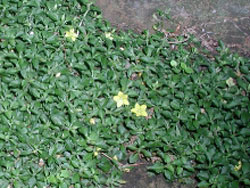Resource Library
Plant of the Week: Moneywort, Dwarf
The University of Arkansas System Division of Agriculture does not promote, support or recommend plants featured in "Plant of the Week." Please consult your local Extension office for plants suitable for your region.
Plant of the Week
Dwarf Moneywort
Latin: Lysimachia japonica var minutissima

Every garden is a small experimental space. As gardeners grow in experience, they become more adept at predicting which plants will prosper in a particular location, but when confronted with a difficult site, most of us start with a little experimentation.
After a decade, I'm ready to declare dwarf moneywort (Lysimachia japonica var. minutissima) the best choice for filling the space between sandstone pavers in my shady garden.
I built my small patio in the shade of a large black oak by bedding large sandstone pavers in a 3-inch deep bed of sand. About an inch of space was left between the stones to serve as a planting nook for small creepers.
I started by planting an assortment of sedums (too shady and wet), brass buttons (too wet), sandwort (too shady), and a few others. A decade later, I have four species still surviving, but the dwarf moneywort is doing the best – that is if you don't consider the moss that will probably one day cover the patio.
Dwarf Japanese moneywort is a tiny herbaceous creeper growing about an inch tall with stems trailing across the surface for a length of 1 to 2 inches by the end of the summer. The more familiar moneywort or creeping Jenny (L. nummularia) too is a trailing plant only a couple inches tall, but its branches may run a foot or two in a single season. Dwarf moneywort leaves die in winter, but during the growing season are a bright, glossy green, about three-eighths inch long and pointed instead of coin-shaped as in the more familiar species.
In May and June, one-quarter inch yellow, star-shaped blooms are held individually above the foliage. Moneyworts are members of the primrose family.
Dwarf moneywort is winning the competitive battle (except against the moss) for dominance in the cracks between the pavers because this microclimate most closely matches the habitat from which it comes, atop the 6,400-foot tall mountain on Yakushima Island off the south coast of Japan.
Its island home is one of the wettest places on earth. Rainfall amounts, depending on the year and location, range from 4- to 12-feet per annum. The natural vegetation is a cryptomeria and rhododendron forest.
Dwarf moneywort is a much-dwarfed naturally occurring botanical variety of the typical Japanese moneywort that is similar in size to creeping Jenny. Japanese scientists have studied the causes of this botanical dwarfism and found it's caused by mutations in the DNA code that program for both fewer and smaller cells in the leaf epidermis.
My patio proves to be an ideal location for dwarf moneywort because it's shady and wet. Even though I don't water often, the plants receive an abundance of moisture every time it rains because all the moisture must enter the soil through cracks. Even a small shower can flood the space between the stones with water.
Since my initial success with this plant, I've moved starts to sunny flagstone paths where it has continued to thrive. In shadier sites, it has reseeded to new locations in the patio, but in sunnier areas, its spread has only been by vegetative growth.
Though it belongs to a group of plants known to be rambunctious (some would say weedy), the dwarf form seems unlikely to ever present a problem because it's so tiny. Dwarf moneywort tolerates foot traffic without problem so long as the soil medium is slightly below the surface of the pavers.
By: Gerald Klingaman, retired
Extension Horticulturist - Ornamentals
Extension News - May 29, 2009
The University of Arkansas System Division of Agriculture does not maintain lists of retail outlets where these plants can be purchased. Please check your local nursery or other retail outlets to ask about the availability of these plants for your growing area.